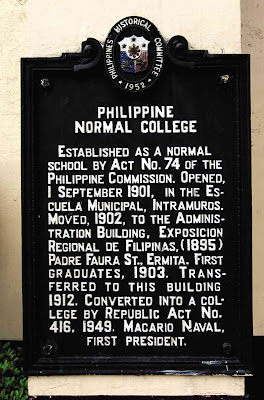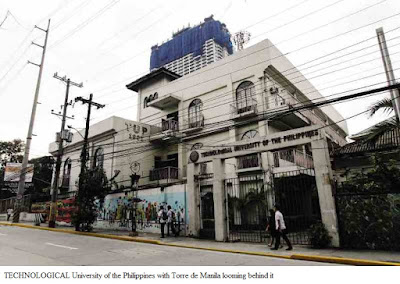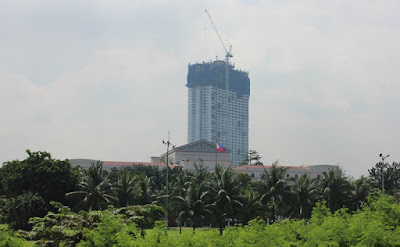Sightline of Rizal Monument in
the Year 2010
Sightline of Rizal Monument in
the Year 2015
Torre de Manila vicinity, a virtual ‘heritage zone’
High-rise is surrounded by several state-declared historical landmarks that the law says must be protected from ‘visual obstruction’ and structural ‘threats’ posed by ‘adjacent constructions’
Torre de Manila was cleared for construction by the National Historical Commission of the Philippines (NHCP) and Manila City Hall despite being located in a virtual “heritage zone” and surrounded by several structures declared as national historical landmarks by government itself, for which, according to the NHCP’s own guidelines, they should be protected from “visual obstruction” and aesthetic “competition.”
Moreover, such landmarks, according to the NHCP guidelines, should be protected from such threats as “adjacent construction activities that may adversely affect historic sites/structures.”
The 49-story Torre de Manila is now the subject of a petition for demolition by the Knights of Rizal with the Supreme Court for allegedly destroying the view of the Rizal Monument.
But the skyscraper may likewise pose as a visual spoiler and structural “threat” to at least eight sites and structures in Ermita, Manila that were declared historic sites by the National Historical Institute and later, National Historical Commission, the predecessors of the NHCP.
These sites have been awarded markers by the NHCP and are considered “national historical landmarks and/or national historical sites” under Republic Act 10066, the National Cultural Heritage Act of 2009, and are therefore protected by law.
These are the St. Vincent de Paul Church, which received its historical marker in 1935; Colegio de Santa Isabel (1947), Philippine Normal University (PNU; 1952 and 2001), Central United Methodist Church (1985), Casino Español de Manila (1993), Technological University of the Philippines (TUP; 2001), Old Legislative Building, which is now the National Art Gallery of the National Museum (NM; 2001) and Adamson University (2007).
Oldest girls school
Located on Taft Avenue, Santa Isabel, which was founded in 1632 during the Spanish era, making it the oldest school for girls in the Philippines and one of the oldest in the world, stands right beside Torre de Manila, which dwarfs it.
Although the original Santa Isabel was in Intramuros and was destroyed during the Second World War, the Taft campus used to be Colegio de Santa Rita, another historically important institution. The Taft campus was purchased after the war by the Daughters of Charity, the congregation that now runs Santa Isabel.
Beside Santa Isabel is the PNU dormitory. Across the dormitory on Burgos Street is PNU itself, the first full teaching school in the country, which has no less than two historical markers put up by the NHCP.
Meanwhile Casino Español on Kalaw Street and Adamson and St. Vincent de Paul on San Marcelino Street are located just behind Torre.
Casino Español is the leisure club of the Spanish community starting from the late 19th century. The original building on Kalaw Street was designed by Juan Arellano but was destroyed during the Second World War. The building as it appears now was constructed in 1951 and was designed by National Artist for Architecture Jose Ma. Zaragoza.
Saint Vincent de Paul Church started as a chapel in the late 19th century during the Spanish era. The present church structure was built in 1912, making it more than 100 years old.
Adamson was established in 1937 originally as a private college offering industrial chemistry and engineering courses. It is now run by the Vincentian fathers.
Last year, Adamson, evincing heritage activism, asked for the remnant of Italian sculptor Francesco Monti’s monumnetal bas relief, “The Furies,” that used to adorn the Old Meralco building on San Marcelino Street, which had been ordered demolished amid heritage protests by Mayor Joseph Estrada.
The Vincentian university later used the remnant to reconstitute the relief and create a replica that now adorns the façade of one of the buildings on its 4-hectare campus.
TUP is the former Manila Trade School established in 1901.
Founded in 1899, the Methodist Church is now a cathedral and is the oldest Protestant church in the Philippines. The original structure was designed by Arellano.
Historic cluster
The cluster of historic sites, which may as well include the Rizal Monument and Luneta (known during the Spanish era as Bagumbayan), should mean that they form, according to R.A. 10066, a “heritage zone.”
The heritage law states that a heritage zone “shall refer to historical, anthropological, archaeological, artistic geographical areas and settings that are culturally significant to the country, as declared by the National Museum and/or the National Historical Institute” (now NHCP).
The law states that the NHCP and NM should declare heritage zones for the protection of the historical and cultural identity of a particular area in coordination with the National Commission for Culture and the Arts and the Housing and Land Use Regulatory Board.
The local government unit is tasked by law to maintain a heritage zone where that zone is located.
Under Section 13 of R.A. 10066, it is provided that the “appearance of streets, parks, monuments, buildings and natural bodies of water, canals, paths and barangays within a locality shall be maintained as close to their appearance at the time the area was of most importance to Philippine history as determined by the National Historical Institute.”
Heritage zone, or “historic center,” is separately defined by the NHCP Guidelines, Policies and Standards for the Conservation and Development of Historic Centers/Heritage Zones, as a “designated area with historical and other special significance, consisting of buildings or group of buildings and their environs that collectively contribute to the area’s importance and character.”
‘Threats’
But even without the declaration of historic centers or heritage zones, the NHCP in its guidelines seeks to enforce protection of historic structures.
The guidelines for example note that one of the offenses against historic or heritage sites and structures is the “visual distraction or obstruction, including power and telecommunication poles and cables.”
Another offense is “competition,” which is defined as “a structure that competes with or subordinates a historic/heritage structure.”
The guidelines also identify a number of threats such as “conflicts with building, fire, electrical codes and local ordinances” and “adjacent construction activities that may adversely affect historic sites/structures.”
Major construction activities around important heritage sites are discouraged by conservation conventions and guidelines of the United Nations Educational, Scientific, Cultural Organization (Unesco) because they may weaken the structural intergrity of the cultural structures and lead to their collapse.
Protection of historical landmarks is part of the mandate of the NHCP. Republic Act 4368, the 1965 law creating the “National Historical Commission,” directs the NHCP to “maintain and care for” monuments and landmarks.
Monuments
The NHCP Guidelines defines a prohibited building as “any structure or establishment that pollutes the environment, obstructs or does not conform to the historical character and/or cultural value of the historic center/heritage zone.”
All non-conforming buildings, the guidelines say, should follow the requirements.
The non-conforming buildings should “conform to or harmonize with the existing characteristics of the site, as to encourage a progressive urban growth anchored on a peaceful coexistence of various historical periods.”
The NHCP Guidelines likewise offers protection for monuments “honoring national heroes, illustrious Filipinos and other personages.”
One of the measures by which a monument’s dominance of the vista is maintained is to “keep vista points and visual corridors to monuments clear for unobstructed viewing appreciation and photographic opportunities.”
The setting of monuments, according to the NHCP Guidelines, “extends to surrounding areas.”
The NHCP Guidelines quotes Article 6 of the Venice Charter on Conservation: “The conservation of the monument implies preserving a setting, which is not out of scale. Wherever the traditional setting exists, it must be kept. No new construction, demolition, or modification, which would alter the relations of mass and color, must be allowed
Other historic structures
Other historically and architecturally significant structures in the vicinity of Torre de Manila are the American-era old Agriculture and Finance buildings on Agrifina Circle, which are now the National Museum of the Filipino People and the Department of Tourism. (The latter will become the soon-to-open Museum of Natural History, also under the National Museum.)
Last October, the Inquirer reported that the National Museum was considering declaring that part of Ermita as a heritage zone.
However, the proposed declaration is only limited to the neoclassic buildings from Pedro Gil Street to the Post Office building on the banks of the Pasig River.
As of press time, the declaration has not been done, said National Museum acting assistant Director and Cultural Properties Division chief Angel Bautista.
Exemption
Despite its own guidelines protecting monuments and historic sites from “visual obstruction” and “competition, the NHCP did not oppose DMCI, the Torre’s developer, which in its original application said it was constructing a 40-story building.
NHCP also did not oppose the DMCI when it sought an exemption from the Manila city government so that it could add nine more floors.
Early last year, DMCI appealed to the Manila City Council for zoning exemption since it said it had obtained permits and passed all of the requirements. Its request was granted by the Manila Zoning Board of Adjustments and Appeals.
After the grant of exemption, Manila Councilor Ernesto Isip authored the resolution supporting the zoning exemption.
This resolution was passed, which paved the way for the construction of the 40-story high rise. It was signed by Councilor Joel Chua, the presiding officer.
In the resolution, no mention was made that City Hall had consulted with NHCP or any of the cultural agencies. No mention was also made of the National Cultural Heritage Act of 2009.
Moreover, such landmarks, according to the NHCP guidelines, should be protected from such threats as “adjacent construction activities that may adversely affect historic sites/structures.”
The 49-story Torre de Manila is now the subject of a petition for demolition by the Knights of Rizal with the Supreme Court for allegedly destroying the view of the Rizal Monument.
These sites have been awarded markers by the NHCP and are considered “national historical landmarks and/or national historical sites” under Republic Act 10066, the National Cultural Heritage Act of 2009, and are therefore protected by law.
Oldest girls school
Located on Taft Avenue, Santa Isabel, which was founded in 1632 during the Spanish era, making it the oldest school for girls in the Philippines and one of the oldest in the world, stands right beside Torre de Manila, which dwarfs it.
Beside Santa Isabel is the PNU dormitory. Across the dormitory on Burgos Street is PNU itself, the first full teaching school in the country, which has no less than two historical markers put up by the NHCP.
Casino Español is the leisure club of the Spanish community starting from the late 19th century. The original building on Kalaw Street was designed by Juan Arellano but was destroyed during the Second World War. The building as it appears now was constructed in 1951 and was designed by National Artist for Architecture Jose Ma. Zaragoza.
Saint Vincent de Paul Church started as a chapel in the late 19th century during the Spanish era. The present church structure was built in 1912, making it more than 100 years old.
Adamson was established in 1937 originally as a private college offering industrial chemistry and engineering courses. It is now run by the Vincentian fathers.
Last year, Adamson, evincing heritage activism, asked for the remnant of Italian sculptor Francesco Monti’s monumnetal bas relief, “The Furies,” that used to adorn the Old Meralco building on San Marcelino Street, which had been ordered demolished amid heritage protests by Mayor Joseph Estrada.
The Vincentian university later used the remnant to reconstitute the relief and create a replica that now adorns the façade of one of the buildings on its 4-hectare campus.
TUP is the former Manila Trade School established in 1901.
Founded in 1899, the Methodist Church is now a cathedral and is the oldest Protestant church in the Philippines. The original structure was designed by Arellano.
Historic cluster
The cluster of historic sites, which may as well include the Rizal Monument and Luneta (known during the Spanish era as Bagumbayan), should mean that they form, according to R.A. 10066, a “heritage zone.”
The heritage law states that a heritage zone “shall refer to historical, anthropological, archaeological, artistic geographical areas and settings that are culturally significant to the country, as declared by the National Museum and/or the National Historical Institute” (now NHCP).
The law states that the NHCP and NM should declare heritage zones for the protection of the historical and cultural identity of a particular area in coordination with the National Commission for Culture and the Arts and the Housing and Land Use Regulatory Board.
The local government unit is tasked by law to maintain a heritage zone where that zone is located.
Under Section 13 of R.A. 10066, it is provided that the “appearance of streets, parks, monuments, buildings and natural bodies of water, canals, paths and barangays within a locality shall be maintained as close to their appearance at the time the area was of most importance to Philippine history as determined by the National Historical Institute.”
Heritage zone, or “historic center,” is separately defined by the NHCP Guidelines, Policies and Standards for the Conservation and Development of Historic Centers/Heritage Zones, as a “designated area with historical and other special significance, consisting of buildings or group of buildings and their environs that collectively contribute to the area’s importance and character.”
‘Threats’
But even without the declaration of historic centers or heritage zones, the NHCP in its guidelines seeks to enforce protection of historic structures.
Another offense is “competition,” which is defined as “a structure that competes with or subordinates a historic/heritage structure.”
The guidelines also identify a number of threats such as “conflicts with building, fire, electrical codes and local ordinances” and “adjacent construction activities that may adversely affect historic sites/structures.”
Major construction activities around important heritage sites are discouraged by conservation conventions and guidelines of the United Nations Educational, Scientific, Cultural Organization (Unesco) because they may weaken the structural intergrity of the cultural structures and lead to their collapse.
Monuments
The NHCP Guidelines defines a prohibited building as “any structure or establishment that pollutes the environment, obstructs or does not conform to the historical character and/or cultural value of the historic center/heritage zone.”
The non-conforming buildings should “conform to or harmonize with the existing characteristics of the site, as to encourage a progressive urban growth anchored on a peaceful coexistence of various historical periods.”
The NHCP Guidelines likewise offers protection for monuments “honoring national heroes, illustrious Filipinos and other personages.”
One of the measures by which a monument’s dominance of the vista is maintained is to “keep vista points and visual corridors to monuments clear for unobstructed viewing appreciation and photographic opportunities.”
The NHCP Guidelines quotes Article 6 of the Venice Charter on Conservation: “The conservation of the monument implies preserving a setting, which is not out of scale. Wherever the traditional setting exists, it must be kept. No new construction, demolition, or modification, which would alter the relations of mass and color, must be allowed
Other historic structures
Other historically and architecturally significant structures in the vicinity of Torre de Manila are the American-era old Agriculture and Finance buildings on Agrifina Circle, which are now the National Museum of the Filipino People and the Department of Tourism. (The latter will become the soon-to-open Museum of Natural History, also under the National Museum.)
Last October, the Inquirer reported that the National Museum was considering declaring that part of Ermita as a heritage zone.
As of press time, the declaration has not been done, said National Museum acting assistant Director and Cultural Properties Division chief Angel Bautista.
Exemption
Despite its own guidelines protecting monuments and historic sites from “visual obstruction” and “competition, the NHCP did not oppose DMCI, the Torre’s developer, which in its original application said it was constructing a 40-story building.
NHCP also did not oppose the DMCI when it sought an exemption from the Manila city government so that it could add nine more floors.
Early last year, DMCI appealed to the Manila City Council for zoning exemption since it said it had obtained permits and passed all of the requirements. Its request was granted by the Manila Zoning Board of Adjustments and Appeals.
After the grant of exemption, Manila Councilor Ernesto Isip authored the resolution supporting the zoning exemption.
This resolution was passed, which paved the way for the construction of the 40-story high rise. It was signed by Councilor Joel Chua, the presiding officer.
In the resolution, no mention was made that City Hall had consulted with NHCP or any of the cultural agencies. No mention was also made of the National Cultural Heritage Act of 2009.
http://lifestyle.inquirer.net/203700/torre-de-manila-vicinity-a-virtual-heritage-zone
Rule of law not followed in Torre de Manila permit – SC Justice Jardeleza
http://www.rappler.com/nation/102980-torre-de-manila-supreme-court-jardeleza
On the Rizal Monument and the Torre de ManilaAbout face, Rizal (Part 1)
http://www.gmanetwork.com/news/story/531376/lifestyle/artandculture/about-face-rizal-part-1
On the Rizal Monument and the Torre de ManilaAbout Face, Rizal (Part 2)
http://www.gmanetwork.com/news/story/532200/lifestyle/artandculture/about-face-rizal-part-2
On the Torre de Manila controversyAbout face, Rizal (Part 3)
http://www.gmanetwork.com/news/story/533155/lifestyle/artandculture/about-face-rizal-part-3
Photos of Rizal Park / Luneta and Torre de Manila
Photo Journal of Fort Santiago - Intramuroshttp://jibraelangel2blog.blogspot.com/2010/10/blog-post.html
*****************************************
Rule of law not followed in Torre de Manila permit – SC Justice Jardeleza
Please read also the related postings:Rule of law not followed in Torre de Manila permit – SC Justice Jardeleza
by Katerina Francisco
Rappler
MANILA, Philippines (UPDATED) – In the 4th round of oral arguments on the controversial Torre de Manila condominium, a Supreme Court (SC) justice said on Tuesday, August 18, that the rule of law was not followed when the Manila city government granted permits for the construction of the 49-story building.
Citing excerpts from Ordinance No. 8119, or the Manila zoning ordinance, SC Associate Justice Francis H. Jardeleza said that 4 layers of protection were ignored when DMCI Homes, the condominium's developer, was given the permits to build the high-rise residential project:
- Buildings under the university cluster, where the Torre de Manila stands, impose a maximum floor-area ratio of 4. Torre de Manila's building plans show that it will have a floor-area ratio of 7.79.
- Section 22 of the ordinance prescribes building regulations in histo-cultural preservation zones.
- Section 23 states that the floor-area ratio requirement should be complied with "in all instances" and that the validity of this requirement will only be superseded by regulations specified for the zone.
- Section 47 requires a heritage impact statement to be submitted to the city planning and development office.
In his 3-hour interpellation of Manila city legal officer Jose Alberto Flaminiano, Jardeleza said that the rule of law was not followed despite the provisions in the ordinance.
Please read more at the below link :
Rappler.com
http://www.rappler.com/nation/102980-torre-de-manila-supreme-court-jardeleza
******************************************
Youtube videos
Blame game in Torre De Manila continues in House probe
DMCI Homes
Torre de Manila | Condo near Roxas Blvd Manila For Sale
Torre De Manila ( DMCI-Homes )
Youtube videos
Mayor Estrada lied to the media, says Alfredo Lim
Blame game in Torre De Manila continues in House probe
Cruz-Araneta: Lim allowed 20-storey Torre de Manila
Legal tussle brews over 'photo bomber' building in Manila
Photos
of Rizal Park / Luneta and Torre de Manila
http://jibraelangel2blog.blogspot.com/2015/08/photos-of-rizal-park-luneta-and-torre.htmlRule of law not followed in Torre de Manila permit – SC Justice Jardeleza
http://www.rappler.com/nation/102980-torre-de-manila-supreme-court-jardeleza
On the Rizal Monument and the Torre de ManilaAbout face, Rizal (Part 1)
http://www.gmanetwork.com/news/story/531376/lifestyle/artandculture/about-face-rizal-part-1
On the Rizal Monument and the Torre de ManilaAbout Face, Rizal (Part 2)
http://www.gmanetwork.com/news/story/532200/lifestyle/artandculture/about-face-rizal-part-2
On the Torre de Manila controversyAbout face, Rizal (Part 3)
http://www.gmanetwork.com/news/story/533155/lifestyle/artandculture/about-face-rizal-part-3
Photos of Rizal Park / Luneta and Torre de Manila
http://jibraelangel2blog.blogspot.com/2015/08/photos-of-rizal-park-luneta-and-torre.html
Photo Journal of Fort Santiago - Intramuroshttp://jibraelangel2blog.blogspot.com/2010/10/blog-post.html
Intramuros – Puerta Real Gardens and Baluarte de San
Diego
http://jibraelangel2blog.blogspot.com/2010/09/intramuros-puerta-real-gardens-and.htm
http://jibraelangel2blog.blogspot.com/2010/09/intramuros-puerta-real-gardens-and.htm







































































